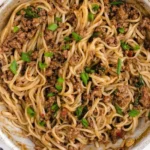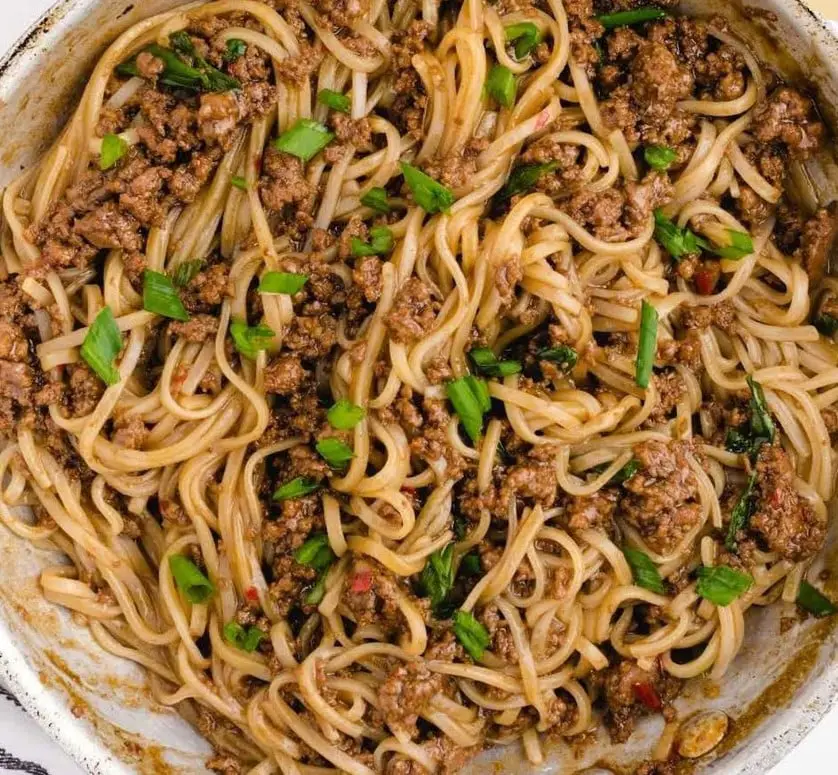Mongolian Ground Beef Noodles offer a delightful fusion of flavors that tantalize the taste buds. This recipe blends the rich umami of ground beef with savory soy sauce, the subtle sweetness of brown sugar, and aromatic garlic and ginger. Combined with tender linguine noodles, this dish promises a satisfying culinary experience that’s both easy to prepare and deeply satisfying.
Ingredients:
- 1 lb ground beef
- 5 cloves garlic, minced
- 1/3 cup brown sugar
- 1/4 cup beef broth
- 1/3 cup soy sauce
- 3 tablespoons hoisin sauce
- 1/2 teaspoon ground ginger
- 1/2 teaspoon ground black pepper
- Pinch of red pepper flake (optional)
- 10 oz linguine
- 1 tablespoon cornstarch
- 2 tablespoons water
- 4 green onions, sliced
Directions:
- Boil the Pasta: Begin by boiling the linguine in a large pot of water according to the package instructions. Once cooked, drain the pasta and set it aside for later use.
- Cook the Ground Beef: In a large skillet over medium-high heat, brown the ground beef until it’s no longer pink. If needed, drain excess fat from the skillet.
- Add Aromatics and Sauces: Stir in the minced garlic and cook until fragrant, approximately 1 minute. Next, incorporate the soy sauce, beef broth, brown sugar, hoisin sauce, ground ginger, black pepper, and red pepper flake (if using). Thoroughly combine all the ingredients.
- Thicken the Sauce: Dissolve the cornstarch in 2 tablespoons of cold water, then add the mixture to the skillet with the ground beef. Stir well and bring the sauce to a gentle boil. Allow the sauce to thicken.
- Combine with Noodles: Once the sauce has reached the desired thickness, add the cooked linguine noodles to the skillet. Stir gently to coat the noodles evenly with the flavorful sauce.
- Absorb Flavor: Let the noodles simmer in the sauce for 2-3 minutes to absorb the delicious flavors.
- Serve and Garnish: Top the Mongolian Ground Beef Noodles with sliced green onions for a refreshing finish.
Tips:
- For a spicier kick, add more red pepper flakes or even a dash of hot sauce to suit your taste preferences.
- Adjust the sweetness and saltiness of the dish by modifying the amount of brown sugar and soy sauce accordingly.
- Ensure that the cornstarch is completely dissolved in water before adding it to the skillet to prevent clumps in the sauce.
Conclusion:
Indulge in the delectable combination of savory ground beef, aromatic garlic, and a medley of Asian-inspired sauces with Mongolian Ground Beef Noodles. This dish offers a satisfying meal that’s quick to prepare and bursting with flavor. Whether enjoyed as a comforting dinner or shared with loved ones, these noodles are sure to become a favorite in your culinary repertoire.
- Can I use other types of pasta instead of linguine?
While linguine works wonderfully in this recipe due to its flat shape and ability to hold onto the sauce, you can certainly experiment with other types of pasta. Spaghetti, fettuccine, or even rice noodles can be suitable substitutes. Keep in mind that cooking times may vary depending on the type of pasta you choose, so be sure to adjust accordingly. - Can I substitute ground beef with other protein options?
Absolutely! While ground beef provides a hearty and rich flavor to the dish, you can easily substitute it with ground chicken, turkey, pork, or even tofu for a vegetarian option. Just ensure that the protein is thoroughly cooked and well-seasoned before adding the other ingredients to the skillet. Each protein choice will offer its own unique flavor profile to the dish. - Is there a way to make this recipe gluten-free?
Yes, you can make this recipe gluten-free by using gluten-free soy sauce and hoisin sauce, as these are the main sources of gluten in the dish. Additionally, opt for gluten-free pasta or rice noodles instead of traditional linguine. Be sure to check the labels of your ingredients carefully to ensure they are certified gluten-free, especially if you have gluten sensitivities or allergies. - How can I customize the level of spiciness in the dish?
The level of spiciness in Mongolian Ground Beef Noodles can be easily adjusted to suit your personal preference. If you prefer a milder flavor, you can omit the red pepper flakes altogether or reduce the amount used in the recipe. On the other hand, if you enjoy a bit more heat, feel free to increase the amount of red pepper flakes or add a dash of your favorite hot sauce to the skillet when preparing the sauce. Taste as you go and adjust accordingly until you reach the desired level of spiciness. - Can I make this recipe ahead of time and reheat it later?
Yes, Mongolian Ground Beef Noodles can be made ahead of time and reheated for later consumption. However, keep in mind that the noodles may absorb more of the sauce as they sit, so you may need to adjust the consistency by adding a bit of broth or water when reheating. Store the cooked noodles and sauce separately in airtight containers in the refrigerator for up to 2-3 days. When ready to enjoy, simply reheat the sauce in a skillet, then add the noodles and stir until heated through. - Can I add vegetables to this recipe?
Absolutely! Adding vegetables can enhance both the flavor and nutritional value of Mongolian Ground Beef Noodles. Bell peppers, broccoli, carrots, snap peas, and mushrooms are all excellent options to consider. Simply sauté the vegetables along with the ground beef until they are tender-crisp before adding the sauce ingredients to the skillet. This allows the vegetables to soak up the flavors of the sauce while retaining their vibrant colors and textures. - How can I make this recipe more nutritious?
To boost the nutritional content of Mongolian Ground Beef Noodles, consider incorporating whole grain pasta or noodles for added fiber and nutrients. You can also add extra vegetables, as mentioned in the previous question, to increase the dish’s vitamin and mineral content. Additionally, lean ground beef or alternative protein sources can help reduce the overall fat content of the dish while still providing ample protein. Lastly, be mindful of the sodium content in the soy sauce and hoisin sauce, and opt for low-sodium varieties if you’re watching your sodium intake.

Mongolian Ground Beef Noodles
- Prep Time: 10 minutes
- Cook Time: 20 minutes
- Total Time: 30 minutes
- Yield: 4 servings 1x
- Category: Main Course
- Method: Asian-Inspired
- Cuisine: Stir-fry
- Diet: Diabetic
Description
This easy Mongolian ground beef noodle dish is a savory and slightly sweet stir-fry that combines tender noodles, seasoned ground beef, and a rich, garlicky sauce. It’s a perfect weeknight meal that comes together quickly, packed with flavor and ideal for a comforting dinner.
Ingredients
- 1 lb ground beef
- 8 oz rice noodles or spaghetti
- 2 tablespoons vegetable oil
- 4 cloves garlic, minced
- 1 tablespoon fresh ginger, minced
- 1/4 cup soy sauce (low sodium)
- 1/4 cup hoisin sauce
- 2 tablespoons brown sugar
- 1 tablespoon rice vinegar
- 1 tablespoon sesame oil
- 1 teaspoon red pepper flakes (optional, for heat)
- 2 green onions, sliced
- 1 tablespoon sesame seeds (for garnish)
Instructions
-
Cook the noodles:
Cook the noodles according to the package instructions. Drain and set aside. -
Cook the ground beef:
In a large skillet, heat vegetable oil over medium-high heat. Add the ground beef and cook until browned, breaking it apart as it cooks. Drain any excess fat. -
Make the sauce:
In the same skillet, add the minced garlic and ginger. Cook for 1-2 minutes until fragrant. Stir in the soy sauce, hoisin sauce, brown sugar, rice vinegar, and sesame oil. Let the sauce simmer for 3-4 minutes. -
Combine everything:
Add the cooked noodles to the skillet with the beef and sauce. Toss everything together until the noodles are well coated. Cook for an additional 2-3 minutes, allowing the flavors to combine. -
Serve:
Garnish with sliced green onions, sesame seeds, and red pepper flakes if using. Serve hot.
Notes
- You can substitute ground beef with ground turkey or chicken for a lighter version.
- Add vegetables like bell peppers, carrots, or broccoli for added nutrition and color.
- Adjust the sweetness or saltiness by modifying the amount of sugar or soy sauce to your preference.

